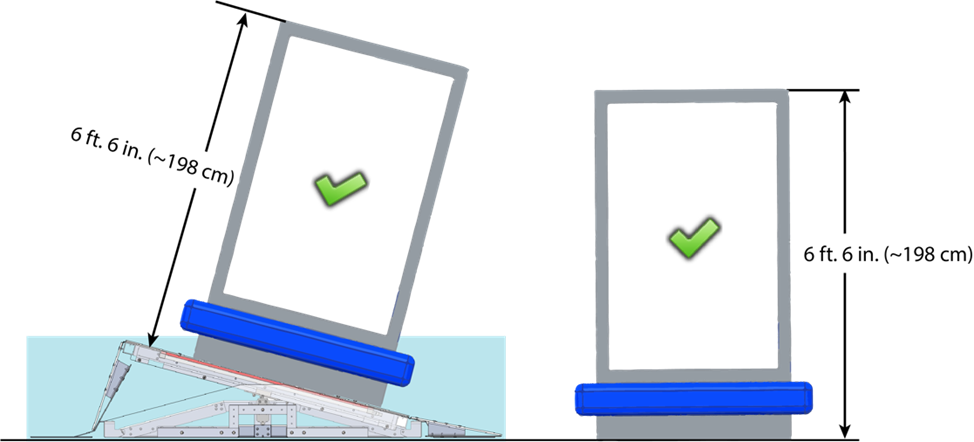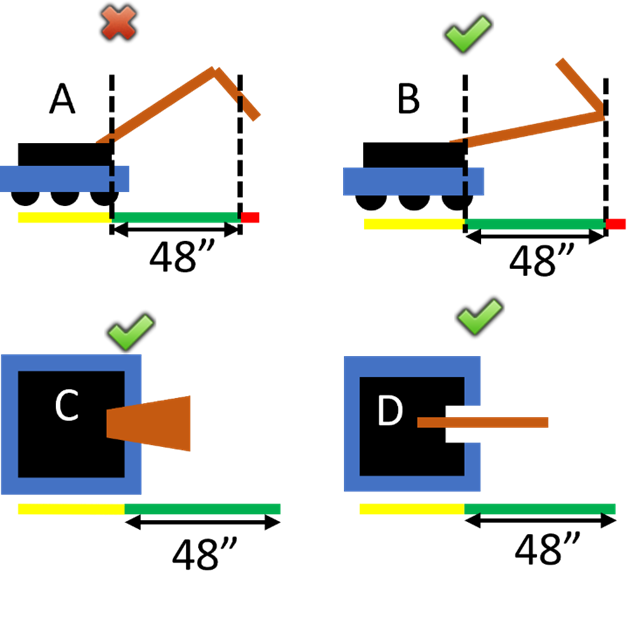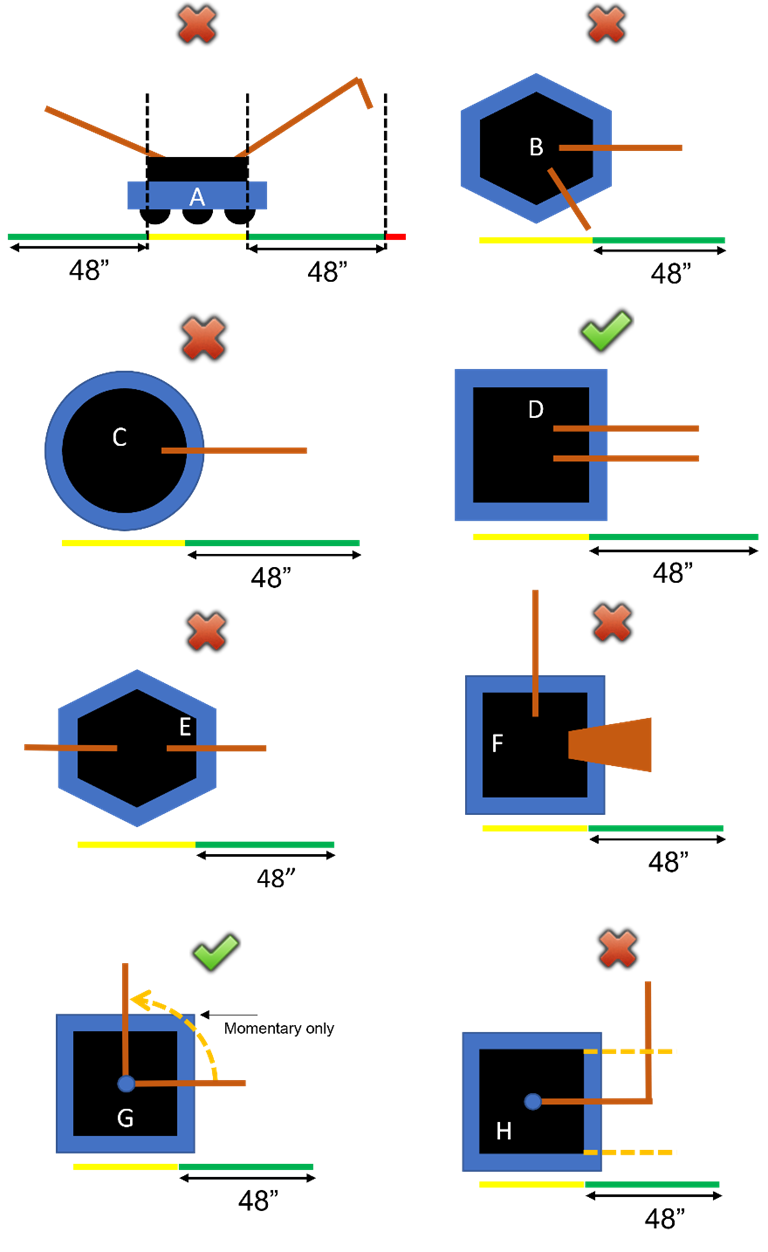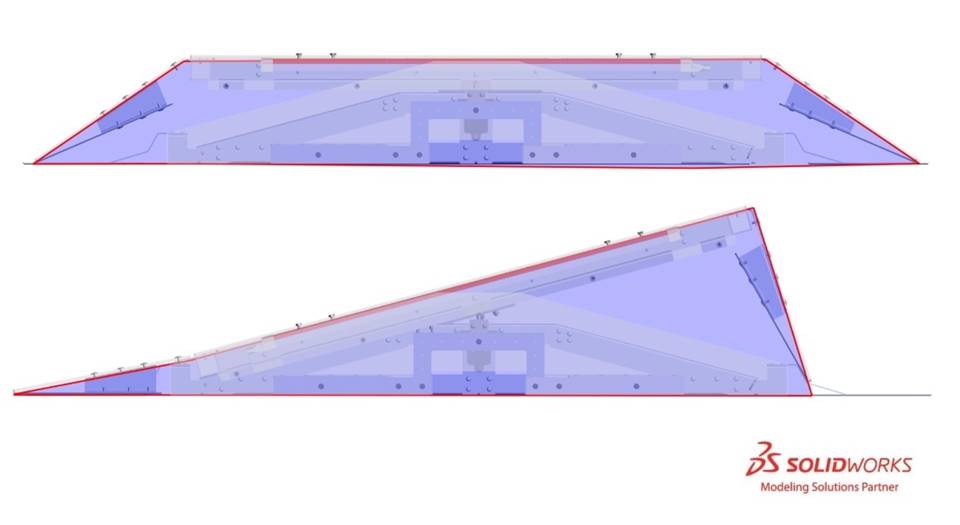7 Game Rules: ROBOTS
7.1 ROBOT Restrictions
G101 *Dangerous Robots: not allowed.
Examples include, but are not limited to:
- a. uncontrolled motion that cannot be stopped by the ,DRIVE TEAM
- b. parts “flailing” outside of theROBOT,FIELD
- c. dragging their battery, andROBOTS
- d. that consistently extend outside theROBOTS.FIELD
G102 *Robots, stay on the Field during the Match.
Please be conscious of
G104 *Keep your Bumpers together.
G106 Tall Robots not allowed.
This measurement is intended to be made as if the
For example, a
Figure 7‑1

G107 Don’t overextend yourself.
Examples of compliance and non-compliance of this rule are shown in Figure 7‑2.
Yellow bars represent the limits of the
- A violates this rule for having an extension that is too longROBOT
- B does not violate this ruleROBOT
- C does not violate this ruleROBOT
- D does not violate this rule Figure 7‑2 Examples of compliance and non-compliance of this ruleROBOT

G108 Opponent’s zone, no extension.
A
Examples of
G109 Don’t extend in multiple directions.
- A. and inconsequential extensions in multiple directions,MOMENTARY
- B. A fully contained within itsROBOTorLOADING ZONE, andCOMMUNITY
- C. movement of aMOMENTARYfrom 1MECHANISMside to an adjacentFRAME PERIMETERside.FRAME PERIMETER
Examples of compliance and non-compliance of this rule are shown in Figure 7‑3.
Yellow bars represent the limits of the
All following examples are legal in
- A violates this rule for extending in more than one directionROBOT
- B violates this rule for extending in more than one directionROBOT
- C violates this rule for extending beyond an infinite number of sides and therefore any extension over an arc extends over multiple sidesROBOT
- D does not violate this ruleROBOT
- E violates this rule for extending in more than one directionROBOT
- F violates this rule for extending in more than one directionROBOT
- G does not violate this rule as long as the extension does not exceed the definition ofROBOTwhen positioned over theMOMENTARYcorner.BUMPER
- H violates this rule for reaching outside the projection of theROBOTside. Figure 7‑3 Examples of compliance and non-compliance of this ruleFRAME PERIMETER

7.2 ROBOT to ROBOT Interaction
G201 *Don’t expect to gain by doing others harm.
Strategies clearly aimed at forcing the opponent
This rule does not apply for strategies consistent with standard gameplay, for example:
- a. a red ALLIANCEin theirROBOTin the final 30 seconds of theCOMMUNITYcontacts a blueMATCHALLIANCE.ROBOT
- b. a blue attempts to cut in front of the redROBOTto reach itsLOADING ZONE, and a nearby redCOMMUNITYtries to impede it via a defensive bump and, as a result, the blueROBOTcrosses into the redROBOT.LOADING ZONE
- c. a blue attempts to enter theirROBOTto score aCOMMUNITYand pushes a redGAME PIECEjust outside the blueROBOTinto the blueCOMMUNITY. This rule requires an intentional act with limited or no opportunity for the team being acted on to avoid the penalty, such as:COMMUNITY
- d. forcing the opposing to have greater thanROBOTMOMENTARYof more than 1CONTROL.GAME PIECE
- e. a blue ALLIANCE, already inROBOTof aCONTROL, pushing a redGAME PIECEALLIANCEfrom fully outside and far from (i.e. more than 4 ft.) the blueROBOTinto the blueLOADING ZONEand theLOADING ZONEperceiving that the blueREFEREEis deliberately making the redROBOTviolate G207.ROBOT
G202 *There’s a 5-count on Pins.
A team’s desired direction of travel is not a consideration when determining if a
If the PINNING
G203 *Don’t collude with your partners to shut down major parts of game play.
2 or more
Examples of violations of this rule include, but are not limited to:
- a. shutting down access to all ,GAME PIECES
- b. quarantining all opponents to a small area of the ,FIELD
- c. blocking all access to the , andLOADING ZONE
- d. blocking all access to the A singleCOMMUNITYblocking access to a particular area of theROBOTis not a violation of this rule.FIELD
2
Note, G204, G205, and G206 are mutually exclusive. A single
G204 *Stay out of other Robots.
A
For the purposes of this rule, “initiate contact” requires movement towards an opponent
In a collision, it’s possible for both
G205 *This isn’t combat robotics.
A
- A. deliberately, as perceived by a .REFEREE
- B. regardless of intent, by initiating contact, either directly or transitively via a CONTROLLED by theGAME PIECE, inside the vertical projection of an opponentROBOT’SROBOT. Contact between theFRAME PERIMETER’SROBOTorBUMPERSinside theCOMPONENTS’SROBOTandFRAME PERIMETERinside an opening of an opponent’sCOMPONENTSor in the space above theBUMPERSopening are exceptions to this rule.BUMPER
Damage or functional impairment because of contact with a tipped-over opponent
FIRST Robotics Competition can be a full-contact competition and may include rigorous game play. While this rule aims to limit severe damage to
The exception in G205-B effectively means that
Examples of violations of this rule include, but are not limited to:
- a. A leaves an arm extended, spins around to change course, and unintentionally hits and damages aROBOTinside theCOMPONENTof a nearby opponentFRAME PERIMETER.ROBOT
- b. A , in the process of trying to quickly reverse direction, tips up on a single pair of wheels, lands atop an opponentROBOT, and damages aROBOTinside that opponent’sCOMPONENT.FRAME PERIMETER
- c. A high-speed rams and/or REPEATEDLY smashes an opponentROBOTand causes damage. TheROBOTinfers that theREFEREEwas deliberately trying to the damage the opponent’sROBOT. Examples of functionally impairing anotherROBOTinclude, but are not limited to:ROBOT
- d. opening an opponent’s relief valve such that the opponent’s air pressure drops and
- e. powering off an opponent’s (this example also clearly results in aROBOTbecause theRED CARDis no longer able to drive). At the conclusion of theROBOT, the HeadMATCHmay elect to visually inspect aREFEREEto confirm violations of this rule made during aROBOTand remove the violation if the damage cannot be verified.MATCH
For the purposes of this rule, “initiating contact” requires movement towards an opponent
In a collision, it’s possible for both
"Unable to drive" means that because of the incident, the
G206 *Don’t tip or entangle.
A
Examples of violations of this rule include, but are not limited to:
- a. using a wedge-like to tip over opponentMECHANISM,ROBOTS
- b. making BUMPER-to-BUMPER contact with an opponent that is attempting to right itself after previously falling over and causing them to fall over again, andROBOT
- c. causing an opponent to tip over by contacting theROBOTafter it starts to tip if, in the judgement of theROBOT, that contact could have been avoided. Tipping as an unintended consequence of normalREFEREEtoROBOTinteraction, as perceived by theROBOT, is not a violation of this rule.REFEREE
"Unable to drive" means that because of the incident, the
G207 Right of way.
A
Teams should take note that they are putting themselves at great risk for
Figure 7‑4: G207 Examples


G208 Don’t climb on each other unless in the COMMUNITY.
A
G209 During the ENDGAME, don’t touch ROBOTS touching their CHARGE STATION.
During the ENDGAME, a
7.3 FIELD Interaction
G301 Be careful what you interact with.
- A. grabbing,
- B. grasping,
- C. attaching to (including the use of a vacuum or hook fastener to anchor to the carpet and excluding use of theFIELDhook-and-loop tape, plugging in to the provided power outlet, and plugging the provided Ethernet cable into theDRIVER STATION),OPERATOR CONSOLE
- D. deforming,
- E. becoming entangled with,
- F. suspending from, and
- G. damaging.
G302 Stay on your side before TELEOP.
Before
If an
G303 Do not interfere with opponent GAME PIECES before TELEOP.
Before
G304 Don’t mess with the opponent’s CHARGE STATION.
- A. movement, or prevention of movement, of an opponent because of aCHARGE STATIONMOMENTARYaction resulting in minimalROBOTmovementCHARGE STATION
- B. a forced to contact an opponent’sROBOTbecause of contact by an opponentCHARGE STATION, either directly or transitively through aROBOTor otherGAME PIECE(e.g. aROBOTwedged underneath theROBOTby the opposingCHARGE STATIONeither intentionally or accidentally).ALLIANCE
G305 Don’t trick the sensors.
Teams may not interfere with automated scoring hardware.
G306 Don’t jam the CHARGE STATION.
A

7.4 GAME PIECES
G401 *Keep GAME PIECES in bounds.
G402 *GAME PIECES: use as directed.
Examples include, but are not limited to:
- a. wedging a under theCUBEto ease ENGAGING andCHARGE STATION
- b. placing a on the opponent’sCONEto make it harder to drive on.CHARGE STATION
G403 1 GAME PIECE at a time (except in LOADING ZONE and COMMUNITY).
A
- A. the is fully supported by theGAME PIECE, orROBOT
- B. the is intentionally moving aROBOTto a desired location or in a preferred directionGAME PIECE
Moving a
Egregious examples include but are not limited to the following:
- a. simultaneous of 3CONTROLGAME PIECES
- b. CONTINUOUSof 2 or moreCONTROLGAME PIECES
- c. frequent of 2 or moreCONTROL(an approximate count for frequent in this context is if this rule is violated more than 3 times in aGAME PIECES)MATCH
G404 Launching GAME PIECES is only okay in the COMMUNITY.
A
A
This rule is not intended to penalize typical movement of
- a. Running an intake in reverse causing a to travel a short distance from theGAME PIECEROBOT
- b. A pushing aROBOTa short distance away in the process of herding it across theGAME PIECEFIELD
G405 Don’t mess with the opponents’ GRIDS.
A
6 MATCH Play
During CHARGED UP, 2 ALLIANCES (an ALLIANCE is a cooperative of up to 4 FIRST Robotics Competition teams) play MATCHES, set up and implemented per the details described below.
8 Game Rules: Humans
FIRST is committed to Equity, Diversity, and Inclusion and as such, FIRST makes reasonable accommodations for persons with disabilities that request accommodation. If a participant needs an accommodation for an event, please talk to a volunteer at the event or contact local leadership before the event so they can help ensure the accommodation is provided.